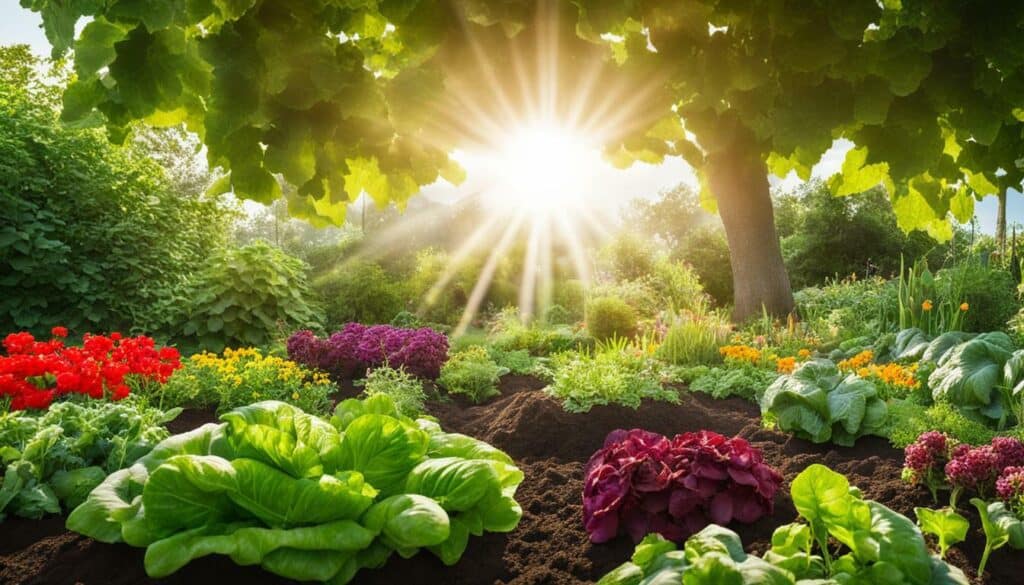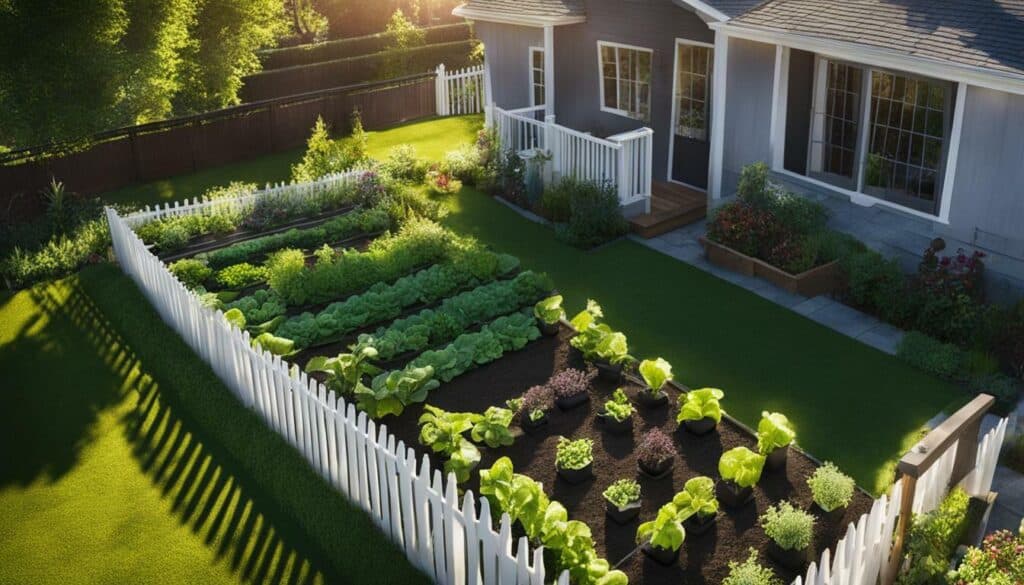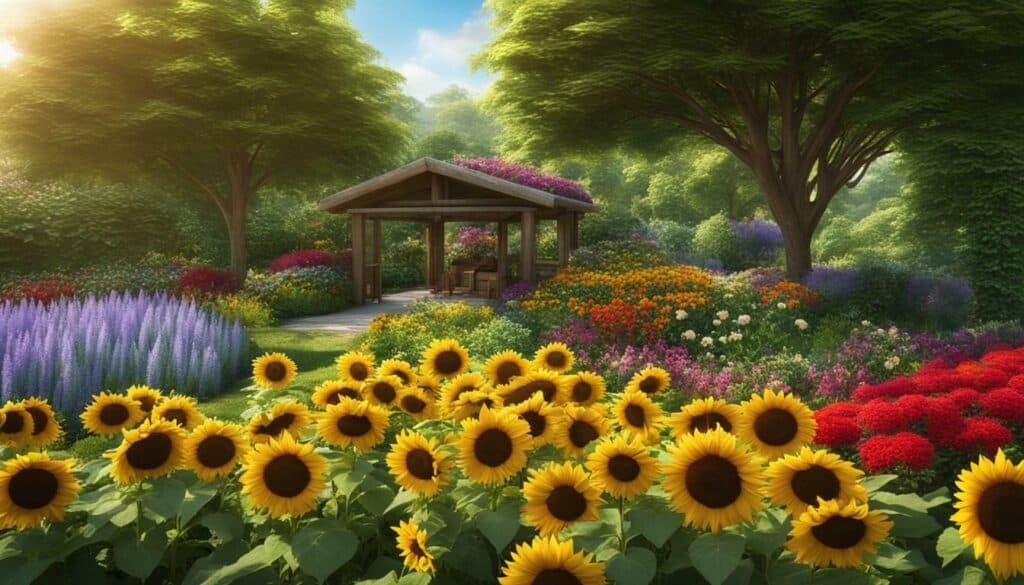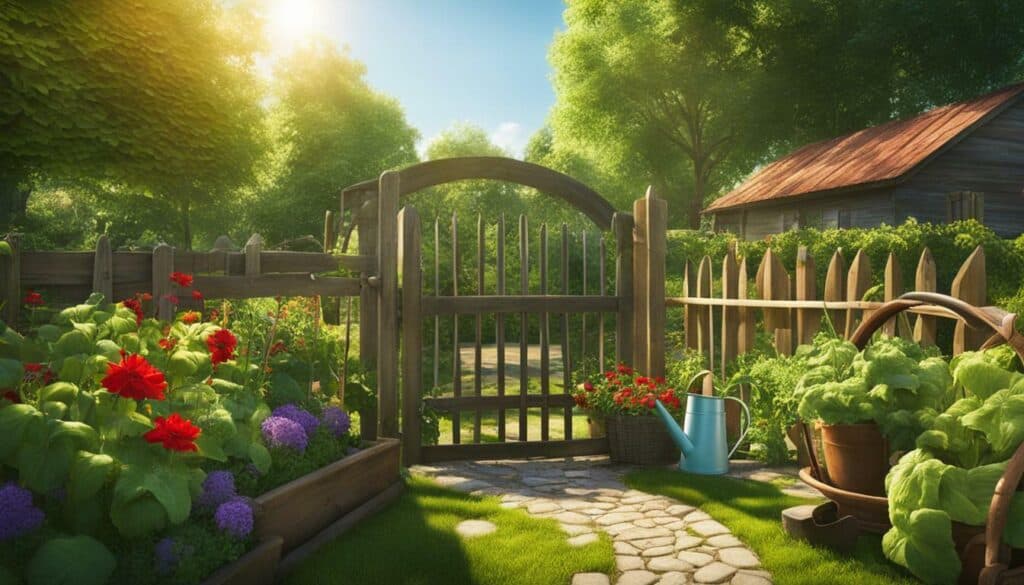Are you interested in starting a backyard garden? Starting a backyard garden can be a rewarding and fulfilling experience. Not only can you grow your own food and reduce your food bill, but you can also enjoy pesticide-free produce and reduce your carbon footprint. If you’re new to gardening, starting small and choosing the right location for your garden is key.
Consider the amount of sunlight your yard gets and the types of vegetables you want to grow. Some easy-to-grow vegetables for beginners include onions, radishes, green beans, salad greens, tomatoes, peppers, potatoes, and strawberries. Knowing your soil type and making sure it’s suitable for gardening is also important.
Clear the ground and put your plants in the ground, following the instructions for each type of seed. Provide adequate water and maintain your garden by watering, fertilizing, and mulching. Remove weeds promptly to ensure your plants get the resources they need.
As a beginner gardener, it’s okay to make mistakes and learn as you go. Composting is a great way to provide natural fertilizer for your plants. Follow these tips to start your own backyard vegetable garden and enjoy the benefits of gardening.
Key Takeaways:
- Starting a backyard garden can help reduce your food bill, provide pesticide-free produce, and reduce your carbon footprint.
- Choosing the right location and size of your garden is important for optimal growth and maintenance.
- Easy-to-grow vegetables for beginners include onions, radishes, green beans, salad greens, tomatoes, peppers, potatoes, and strawberries.
- Knowing your soil type is crucial for gardening success.
- Maintain your garden by watering, fertilizing, mulching, and promptly removing weeds.
- Composting is a great way to provide natural fertilizer for your plants.
Choosing the Right Garden Size and Location
To begin, choose the right garden size, considering starting small if you’re a beginner. A small garden that is easy to maintain and expand is recommended. Also, consider the location of the garden. A good spot for your backyard garden should have access to good sunlight and water. Vegetables need at least 6 hours of sunlight daily, so choose a spot that receives ample sunlight.
The right location will also have good drainage and be easy to access for watering and weeding. When choosing a location, take into account the types of vegetables you plan to plant and how much time you can dedicate to tending them. Some vegetables require more care and attention than others and may not be suitable for beginners.
Knowing your soil type is critical to your garden’s success. Soil types can be sandy, loamy, or clay. Sandy soil drains quickly but may require more watering, while clay soil retains moisture but can be challenging to work with. You can purchase a soil testing kit to determine your soil type.
Once you have chosen your garden location and assessed your soil type, it’s time to prepare the ground for planting. Clear the ground of any debris and break up the soil with a hoe or rake. Consider using a garden bed for your plants, raised beds are ideal for those with poor soil or drainage issues.
When selecting your plants, keep in mind their growth size and ensure that they have sufficient space to flourish. Plant taller plants in the back of the garden and shorter plants in the front. Read and follow the instructions on seed packets to ensure you’re planting properly. Keep your garden weed-free by tilling the soil or using mulch to prevent weed growth. Adequate watering and regular maintenance, including fertilizing and pruning, will keep your garden thriving.
Having the right gardening tools is essential to success. Some necessary tools include a hoe, spade, garden fork, trowel, rake, pruning shears, and watering can. Don’t forget to wear gloves to protect your hands from cuts and scratches.
Gardening can be a fun and rewarding experience. Gardening provides fresh produce that is free of pesticides and chemicals, and it’s also an excellent way to get some exercise and fresh air. Don’t let the fear of failure stop you from starting your backyard garden. With a little patience and dedication, you can enjoy the fruits of your labor in no time.
Selecting Suitable Vegetables for Beginners
Choosing the right vegetables to plant in your backyard garden is crucial for your success as a beginner gardener. It is best to start with easy-to-grow vegetables like onions, radishes, green beans, salad greens, tomatoes, peppers, potatoes, and strawberries. These vegetables require minimum care and are perfect for newcomers to gardening.
Consider the size of your garden and the amount of sunlight it receives before selecting vegetables. Some vegetables, like tomatoes and peppers, require full sun, while others, like lettuce and spinach, thrive in partial shade. Choose the right location and size for your garden to ensure optimal growth and maintenance.
In addition to considering sunlight and garden size, it is important to select vegetables that can be harvested year-round. Choose a variety of warm and cool-weather vegetables to ensure a continuous and abundant harvest.
Clearing the ground and knowing your soil type are important steps in preparing the garden. Prepare the soil by removing weeds and rocks and adding organic matter to improve its quality. Adequate water and maintenance, including regular watering and fertilizing, should also be provided for the plants.
It is important to stay consistent with the gardening process and to explore composting as a natural way to fertilize the soil. With patience and commitment, gardening can be a rewarding and enjoyable activity that provides fresh produce and numerous health benefits.

Knowing Your Soil Type for Optimal Growing Conditions
It’s important to know your soil type to ensure optimal growing conditions for your backyard garden plants. This can be determined by performing a simple soil test. Sandy soil feels gritty to the touch, while powdery soil typically has an excess of silt. If your soil is sticky and wet, it may contain a high concentration of clay.
| Soil Type | Description | Improvement |
|---|---|---|
| Sandy soil | Feels gritty | Adding organic matter |
| Silty soil | Excess of silt | Adding organic matter |
| Clay soil | Sticky and wet | Raised beds may be necessary |
Once you know your soil type, you can make informed decisions when choosing which plants to grow in your backyard garden. Providing adequate water and maintenance is also crucial for a thriving garden. Remember to regularly tend to your plants, remove weeds, and fertilize the soil with compost.
Gardening is a rewarding and fulfilling hobby that can provide numerous health benefits. So, don’t be intimidated and give it a try!

Preparing the Ground for Planting
Clear the ground by either digging out the sod or smothering it with newspaper. This can be accomplished by laying down a layer of newspaper several pages thick over the area you want to plant. Then, add a layer of mulch, such as compost or straw, over the newspaper. This will smother the grass and weeds and provide a nutrient-rich base for your plants.
The size and location of your garden are crucial factors in the success of your vegetable garden. Choose a location that receives at least six hours of sunlight a day and is easily accessible for watering and maintenance. You can start small with a raised bed or container garden if you have limited space or are new to gardening.
Consider the types of vegetables you want to plant and their sunlight requirements. Some vegetables, such as tomatoes and peppers, require full sun, while others, such as leafy greens, can tolerate partial shade. Knowing your soil type is also crucial in creating an optimal growing environment.
Once you have chosen the location and size of your garden, it’s time to prepare the ground. Clearing the ground by removing sod or smothering it with newspaper is necessary before planting. Digging out the sod is time-consuming but effective. Alternatively, you can smother the grass by covering it with newspaper and a layer of mulch, as mentioned above.
Next, follow the instructions for each type of seed and plant accordingly. Provide adequate water and maintenance, including regularly tending to the plants and removing weeds. Mulch can also be used to conserve water and deter weeds.
Overall, starting a garden can be a rewarding and enjoyable experience that yields fresh, pesticide-free produce and reduces your carbon footprint. Take the time to prepare your ground properly, and your vegetable garden is sure to thrive.

Planting Your Vegetables
Planting your vegetables can be a rewarding and beneficial experience. There are many benefits to growing your own food, such as reducing your monthly food bill, growing pesticide-free produce, and reducing your carbon footprint. To begin, choose the right garden size and location. Consider the types of vegetables you want to plant and ensure that the garden area receives an adequate amount of sunlight. Understand your soil type and clear the ground before putting your plants in the ground.
Then, put your plants in the ground following the instructions on the seed packet. Make sure to keep a few things in mind:
- Choose the right seeds and soil. Some plants may require specific types of soil to thrive, so do your research beforehand.
- Be consistent in caring for your plants. Water them regularly and provide adequate nutrients.
- Composting is another great way to provide natural fertilizer for your garden. Collect food scraps and yard waste to create compost and add it to your garden for added nutrients.

Remember to keep an eye out for weeds and tend to your plants regularly. Weeds can compete with your plants for nutrients and water, so it’s important to remove them promptly. Maintaining your garden by sticking to a consistent watering schedule, fertilizing your garden, and keeping weeds in check will help ensure a successful harvest. Gardening can be a rewarding hobby that brings joy and produces beautiful results. By following these tips, you’ll be on your way to a bountiful backyard garden in no time!
Watering and Garden Maintenance
Providing adequate water is crucial for a successful backyard garden, especially for small seedlings. Water your plants regularly and stick to a consistent watering schedule. Keep in mind that overwatering can be just as harmful as underwatering, so be sure to monitor the moisture levels of the soil.
In addition to watering, garden maintenance is essential for optimal plant growth. This includes fertilizing, laying down mulch, and promptly pulling out weeds. Fertilizing with natural options like compost or organic fertilizers can contribute to healthier plants and tastier vegetables.
When it comes to mulch, consider using organic materials like leaves or grass clippings to improve soil quality and regulate soil temperature. Additionally, laying down mulch can help prevent weeds from sprouting, reducing the amount of time spent weeding.
It is important to promptly pull out weeds as they can compete with plants for water and nutrients, leading to stunted growth and decreased yield.
Regularly inspect your plants for signs of pests or diseases. Early detection can prevent the spread of diseases and minimize damage to your plants.
Remember to enjoy the process of maintaining your backyard garden and not to be discouraged by failures. Gardening is a lifelong pursuit that brings joy and beauty to your yard while providing fresh produce and many health benefits.

Backyard garden maintenance
The Joy of Gardening
Gardening can be a fun and healthy activity that brings you closer to nature. There’s nothing quite like the satisfaction of growing your own food and enjoying the fresh flavors of your harvest. But the benefits of gardening go beyond just delicious and nutritious produce.
Growing your own food can also help reduce your monthly food bill and carbon footprint, as well as ensure that you’re consuming safe, pesticide-free produce. Plus, getting outside and working in your garden can be a great way to get some fresh air, sunshine, and exercise, while also relieving stress and improving mental well-being.
Starting your own backyard vegetable garden is easier than you might think. Begin by choosing the right size and location for your garden, making sure it receives a good amount of sunlight and is easily accessible. Consider the types of vegetables you want to grow, including easy-to-grow options like onions, radishes, salad greens, tomatoes, peppers, potatoes, and strawberries.
When choosing vegetables to plant, take into account the amount of sun your yard receives and consider warm-weather and cool-weather vegetables for year-round harvests. Knowing your soil type is also essential for a successful garden. Determine if your soil contains too much sand, silt, or clay, and make adjustments accordingly.
Before planting, clear the ground by removing sod or smothering it with newspaper. Then, plant your vegetables according to the instructions for each type of seed. Provide adequate water, maintain a consistent watering schedule, and fertilize your garden. Lay down mulch to keep water in and weeds out. Regularly tend to your plants by removing weeds and protecting them from animals.
Gardening is a rewarding and beneficial hobby that anyone can enjoy. So, get started and enjoy the joy of gardening today.

Conclusion
In conclusion, starting a backyard garden is a rewarding and fulfilling experience that offers numerous benefits. By growing your own food, you can reduce your monthly food bill, enjoy pesticide-free produce, and reduce your carbon footprint. To start your backyard vegetable garden, you should carefully choose the appropriate garden size, location, and vegetables. Always consider the amount of sunlight and the type of soil in the area where you plan to plant your garden.
Clear the ground by either digging out sod or smothering it with newspaper to prevent weeds from growing. Once the ground is cleared, it’s time to put your plants in the ground and provide adequate watering. Don’t forget to regularly tend to your plants by fertilizing and removing weeds or pests.
Creating a thriving garden takes time, effort, and patience. However, with the right knowledge and tools, you can create a beautiful outdoor space that brings you joy and fresh produce. So, get your hands dirty, have fun, and don’t give up if things don’t go as planned. Remember, gardening is a lifelong pursuit that can provide numerous health benefits and a deeper connection to nature.

“The glory of gardening: hands in the dirt, head in the sun, heart with nature. To nurture a garden is to feed not just the body, but the soul.” – Alfred Austin
Conclusion
In conclusion, starting a backyard garden is a rewarding and fulfilling experience that offers numerous benefits. Not only can it reduce your monthly food bill by growing pesticide-free produce, but it can also reduce your carbon footprint by providing fresh, local food. Gardening can be a great way to enjoy fresh air, relieve stress, and get some exercise, while also providing beautiful flowers and homegrown herbs.
When starting a garden, it’s important to choose the right size and location based on your time and sunlight availability. It’s also crucial to select the right vegetables for beginners, to know your soil type, and to clear the ground before planting. Once your plants are in the ground, proper watering and maintenance are key to success. Regularly tending to your garden and removing any weeds or pests will ensure healthy growth.
To make the process easier, it’s important to have the necessary gardening gear and to choose the right plants. Starting a garden can be a fun and enjoyable hobby that can provide you with delicious homegrown produce. With patience and dedication, anyone can have a successful backyard garden.
What Are the Best Tips for Someone Starting Their First Backyard Garden?
When venturing into your first backyard garden, a few essential first time gardener tips can help set you on the path to success. Start by selecting suitable plants for your specific climate and gardening skill level. Prepare the soil by removing weeds and incorporating organic matter. Proper watering, regular pest control, and consistent monitoring of your garden’s progress are also key to cultivating a thriving backyard oasis. Finally, don’t forget the joy that comes from nurturing your plants and celebrating each small accomplishment along the way.
FAQ
Q: What are the benefits of starting a backyard garden?
A: Starting a backyard garden can help reduce your monthly food bill, provide pesticide-free produce, and reduce your carbon footprint.
Q: How do I choose the right garden size and location?
A: To choose the right garden size, consider starting small if you’re a beginner. Select a location that gets ample sunlight and is close to your house for easy maintenance.
Q: What vegetables are suitable for beginners?
A: Easy-to-grow vegetables for beginners include onions, radishes, green beans, salad greens, tomatoes, peppers, potatoes, and strawberries. Consider the amount of sun your yard gets each day when picking the vegetables.
Q: Why is it important to know my soil type?
A: Understanding your soil type is crucial to create optimal growing conditions for your plants.
Q: How do I prepare the ground for planting?
A: Clear the ground by either digging out the sod or smothering it with newspaper.
Q: How do I plant my vegetables?
A: Put your plants in the ground following the instructions on the seed packet.
Q: How do I water and maintain my garden?
A: Provide adequate water, especially for small seedlings. Stick to a consistent watering schedule and promptly remove weeds to keep your garden well-maintained.
Q: What are the joys of gardening?
A: Gardening can be a fun and healthy activity that brings you closer to nature.
Q: What is the summary of starting a backyard garden?
A: Starting a backyard garden is a rewarding experience that can save you money, provide healthy produce, and reduce your environmental impact.
Source Links
- https://portfarms.com/finding-your-green-thumb/
- https://www.theteenmagazine.com/beginner-s-guide-to-gardening-5-tips-for-a-green-thumb
- https://greenthumbrevival.com/backyard-vegetable-garden/
- https://www.bhg.com/gardening/yard/garden-care/ten-steps-to-beginning-a-garden/
- https://www.wikihow.com/Start-a-Garden
- https://sebsnjaesnews.rutgers.edu/2020/04/choosing-the-right-location-for-your-vegetable-garden/
- https://www.gardensthatmatter.com/choose-garden-location/
- https://www.almanac.com/where-put-vegetable-garden
- https://www.almanac.com/vegetable-gardening-for-beginners
- https://shiftingroots.com/10-easy-vegetables/
- https://www.bhg.com/gardening/vegetable/vegetables/planning-your-first-vegetable-garden/
- https://www.thisoldhouse.com/gardening/91409/types-of-soil
- https://www.familyhandyman.com/article/types-of-soil-for-your-garden/
- https://www.marthastewart.com/8366183/how-to-identify-soil-type
- https://growitbuildit.com/how-to-start-a-vegetable-garden-in-your-backyard/
- https://www.almanac.com/soil-preparation-how-do-you-prepare-garden-soil-planting
- https://frugalfamilyhome.com/home/gardening/how-to-start-a-vegetable-garden-from-scratch
- https://www.outdoorhappens.com/how-to-start-a-vegetable-garden-from-scratch-in-your-backyard-step-by-step-guide/
- https://www.eater.com/23763380/joy-of-gardening-disability-activism-charis-hill
- https://www.mayoclinichealthsystem.org/hometown-health/speaking-of-health/dig-into-the-benefits-of-gardening
- https://onedegreeorganics.com/healthy-soil-and-the-joy-of-gardening/
- https://growingourown.wordpress.com/6-conclusion/
- https://www.agrifarming.in/how-to-start-a-backyard-garden-from-scratch-a-step-by-step-guide-for-beginners





Leave a Reply